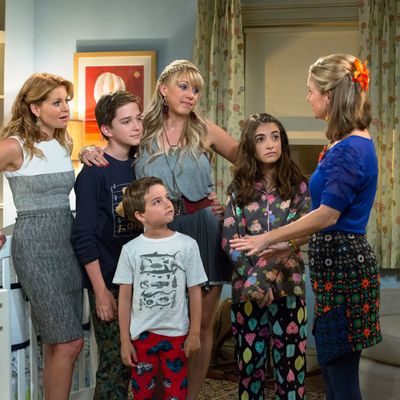
The first four minutes of Fuller House are four of the most excruciating TV minutes ever broadcast; shrill, garish, unfunny, and further poisoned by the live audience’s baffling apparent appetite to hear the catchphrases of the show repeated now, in modernity. “How rude” elicits applause. Future societies will have no choice but to judge us harshly for our sins.
But after those torturous first minutes, things kinda pick up, and the rest of Fuller House is fine, in the unlikely event that you might find yourself in need of something almost exactly like Full House, except newer. Netflix’s revival of the TGIF staple opens with the Tanners et al. reunited (except for Michelle, because Mary-Kate and Ashley Olsen declined to participate), but the show quickly moves on from this way-too-full house and hands things over: D.J. takes over the Danny spot as a young widow with three sons — a snarky tween, a fastidious and extremely adorable 7-year-old, and an infant. Stephanie moves in to help her, taking on Uncle Jesse duties, and BFF Kimmy Gibbler becomes Joey, moving in and bringing her own tween daughter along. For all the talk about getting the whole cast back together, we really only see Bob Saget, John Stamos, Dave Coulier, and Lori Laughlin in passing. Instead, the new show is anchored by Candace Cameron Bure, with Jodie Sweetin and Andrea Barber singing backup. Also, there is a dog.
As far as revivals go, Fuller House achieves the dream of being very much like its original but a little bit better overall, while cycling in familiar faces and including those “remember the old days?” moments. The first episode overindulges in the mirroring of the original show, but that’s almost a meta nod, given how Full House was itself extremely indulgent in all the worst possible ways. Let’s be direct: Full House was and is the kind of garbage schlock any society would be better without. It was poorly written, hammily acted, and even children, at whom it was aimed, were able to recognize the show’s too-gooey nature. How does a culture decide that “You got it, dude,” when slurred by a toddler, is a punch line? Or even just something worth repeating, let alone something worth repeating for eight years? The world is so full of mysteries, one has to wonder how humanity achieves anything at all.
But while Fuller House is bad, it’s endurable, and it works well when assessed on its own terms. It can go toe-to-toe with Girl Meets World, and it is perhaps about as good as Dog With a Blog. (No, I can’t believe that’s a sentence either.) In the interest of forthrightness, I confess: I cried at Fuller House. It was during the opening credits of the second episode, and I had a madeleine moment thanks to an old shot of D.J. Tanner lying on her bed, talking on the phone. I didn’t even remember that I remembered that image from the original opening credits, but apparently I did, and suddenly it was like my older sister had grown up again, right before my eyes, in the span of a few seconds.
I confess this embarrassing incident because even I, a person unwillingly moved to tears by the show, still find myself profoundly unable to care about, enjoy, or invest in the series in any way. “Wow, D.J. Tanner reminds me of my sister so, so much,” I said to myself as I actively rejected the show and everything it stands for.
This show does not exist in isolation. We all live in this world together, and it’s hard to think of something our planet needs less than it needs a Full House revival. There was plenty of Full House to start with, and there are plenty of corny shows aimed at young viewers. We have enough shows that make Dirty Dancing jokes, shows where the stinkiness of baby shit is a central joke source, shows with precocious children, shows with Strong Family Values. Fuller House’s great achievement is that it is not the absolute worst show in history. That cannot possibly be reason enough to make something.

